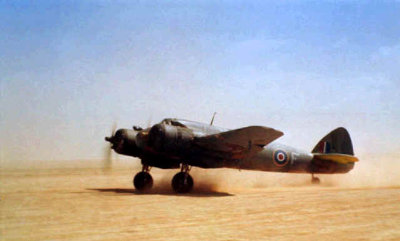![]() The Pacific War Online Encyclopedia
The Pacific War Online Encyclopedia
|
| Previous: Beary, Donald B. | Table of Contents | Next: Beaufort, British Torpedo Bomber |

Bristol Type 156 Beaufighter VI
| Crew | 2 |
| Dimensions | 57'10" by 41'8" by 15'10" 17.63m by 12.70m by 4.83m |
| Weight | 14,600-21,600 lbs 6620-9800 kg |
| Speed | 333 mph at 15,600 feet 536 km/h at 4800 m |
| Climb rate | 31 fps 9.4 m/s |
| Ceiling | 26,500 feet 8080 m |
| Power plant | Two 1670 hp (1245 kW) Bristol Hercules XVI 14-cylinder sleeve-valve radials driving three-bladed propellers |
| Armament | 4 20mm Hispano
cannon fixed in underside of forward
fuselage One 0.303 Vickers K machine gun aimed by navigator Six 0.303 Browning machine guns, two fixed in left wing and four in right. |
| External stores | One 1600 lb (728kg) torpedo
on
centerline or
two
1000 lb (454kg) bombs. Wing racks for eight rocket projectiles could replace the wing machine guns. |
| Range | 1540 miles 2500 km |
| Fuel |
550 gallons 2082 liters |
| Production | A total of 5564 Beaufighters were build in England and 364 in Australia. English production was 1851 Beaufighter VI, 2205 X and 163 XIC. The Australian production was 364 Beaufighter 21. |
| Variants |
Night fighter versions carried the AI Mk IV
radar. The Beaufighter X was armed with both rockets and wing machine guns. The Beaufighter 21 replaced the wing 0.303s with 0.50 machine guns and had a Sperry autopilot, but no torpedo capability. |
The Beaufighter was the result of an
attempt to put a
heavily armed long-range fighter into production using existing jigs as
much as
possible. Though not successful in the day fighter role, the
Beaufighter
was used in the Southwest
Pacific with much success for low-level
attacks. It was also modified for night fighter
operations,
at which it
excelled, due to its heavy armament and an optically flat windshield
that gave the pilot a wonderful undistorted view ahead of his aircraft.
The design dated back to 1939, when aircraft
designer Leslie Frise and Hercules engine designer Fedden discussed the
idea of a long-range cannon-armed escort fighter based on the the Blenheim and Beafort
designs. They proposed a twin-engined two-seater fighter with massive
armament, and by using existing Beaufort jigs they were able to produce
a prorotype in just six months. The aircraft was very tough and
unusually maneuverable for its size and proved capable of extensive
further development. Although early models lacked speed, they were
badly needed as night fighters, where speed was judged less important.
The Japanese nicknamed the Beaufighter the "Whispering Death" because its Hercules sleeve-valve radial engine was extremely quiet. It was one of a handful of aircraft types produced by the nascent Australian aircraft industry during the war, although aircraft produced in England also saw service in the Far East and southwest Pacific.
References
The Pacific War Online Encyclopedia © 2007, 2009, 2012 by Kent G. Budge. Index